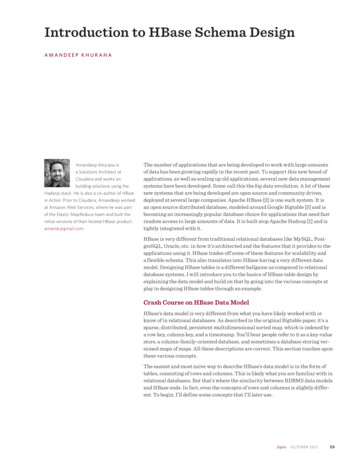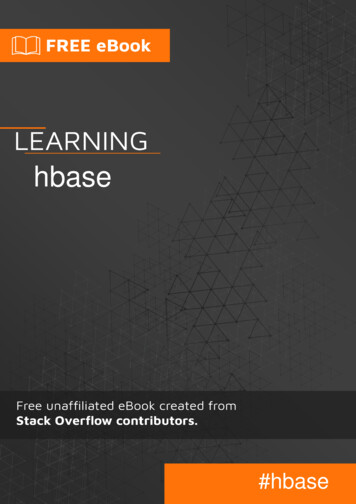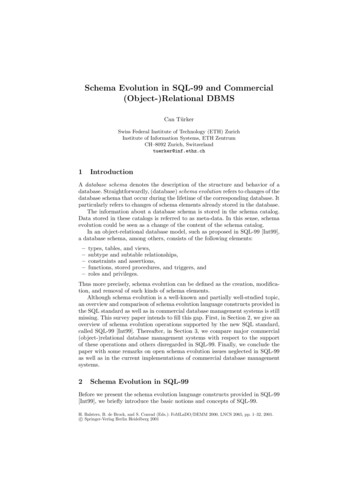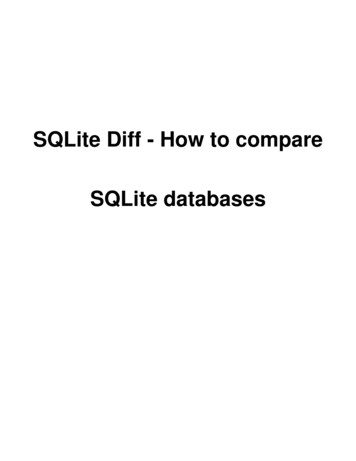
Transcription
Introduction to HBase Schema DesignAm a n d ee p K h u r a n aAmandeep Khurana isa Solutions Architect atCloudera and works onbuilding solutions using theHadoop stack. He is also a co-author of HBasein Action. Prior to Cloudera, Amandeep workedat Amazon Web Services, where he was partof the Elastic MapReduce team and built theinitial versions of their hosted HBase product.amansk@gmail.comThe number of applications that are being developed to work with large amountsof data has been growing rapidly in the recent past. To support this new breed ofapplications, as well as scaling up old applications, several new data managementsystems have been developed. Some call this the big data revolution. A lot of thesenew systems that are being developed are open source and community driven,deployed at several large companies. Apache HBase [2] is one such system. It isan open source distributed database, modeled around Google Bigtable [5] and isbecoming an increasingly popular database choice for applications that need fastrandom access to large amounts of data. It is built atop Apache Hadoop [1] and istightly integrated with it.HBase is very different from traditional relational databases like MySQL, PostgreSQL, Oracle, etc. in how it’s architected and the features that it provides to theapplications using it. HBase trades off some of these features for scalability anda flexible schema. This also translates into HBase having a very different datamodel. Designing HBase tables is a different ballgame as compared to relationaldatabase systems. I will introduce you to the basics of HBase table design byexplaining the data model and build on that by going into the various concepts atplay in designing HBase tables through an example.Crash Course on HBase Data ModelHBase’s data model is very different from what you have likely worked with orknow of in relational databases. As described in the original Bigtable paper, it’s asparse, distributed, persistent multidimensional sorted map, which is indexed bya row key, column key, and a timestamp. You’ll hear people refer to it as a key-valuestore, a column-family-oriented database, and sometimes a database storing versioned maps of maps. All these descriptions are correct. This section touches uponthese various concepts.The easiest and most naive way to describe HBase’s data model is in the form oftables, consisting of rows and columns. This is likely what you are familiar with inrelational databases. But that’s where the similarity between RDBMS data modelsand HBase ends. In fact, even the concepts of rows and columns is slightly different. To begin, I’ll define some concepts that I’ll later use.;login: O C TO B E R 2 0 1 2 29
u Table: HBase organizes data into tables. Table names are Strings and composedof characters that are safe for use in a file system path.u Row: Within a table, data is stored according to its row. Rows are identifieduniquely by their row key. Row keys do not have a data type and are alwaystreated as a byte[ ] (byte array).u Column Family: Data within a row is grouped by column family. Columnfamilies also impact the physical arrangement of data stored in HBase. For thisreason, they must be defined up front and are not easily modified. Every row in atable has the same column families, although a row need not store data in all itsfamilies. Column families are Strings and composed of characters that are safefor use in a file system path.u Column Qualifier: Data within a column family is addressed via its columnqualifier, or simply, column. Column qualifiers need not be specified in advance.Column qualifiers need not be consistent between rows. Like row keys, columnqualifiers do not have a data type and are always treated as a byte[ ].u Cell: A combination of row key, column family, and column qualifier uniquelyidentifies a cell. The data stored in a cell is referred to as that cell’s value. Valuesalso do not have a data type and are always treated as a byte[ ].u Timestamp: Values within a cell are versioned. Versions are identified by theirversion number, which by default is the timestamp of when the cell was written.If a timestamp is not specified during a write, the current timestamp is used. Ifthe timestamp is not specified for a read, the latest one is returned. The numberof cell value versions retained by HBase is configured for each column family.The default number of cell versions is three.A table in HBase would look like Figure 1.Figure 1: A table in HBase consisting of two column families, Personal and Office, each havingtwo columns. The entity that contains the data is called a cell. The rows are sorted based onthe row keys.These concepts are also exposed via the API [3] to clients. HBase’s API for datamanipulation consists of three primary methods: Get, Put, and Scan. Gets andPuts are specific to particular rows and need the row key to be provided. Scans aredone over a range of rows. The range could be defined by a start and stop row key orcould be the entire table if no start and stop row keys are defined.Sometimes, it’s easier to understand the data model as a multidimensional map.The first row from the table in Figure 1 has been represented as a multidimensional map in Figure 2.30 ;login:Vo l. 37, No. 5
The row key maps to a list of column families, which map to a list of column qualifiers, which map to a list of timestamps, each of which map to a value, i.e., the cellitself. If you were to retrieve the item that the row key maps to, you’d get data fromall the columns back. If you were to retrieve the item that a particular columnfamily maps to, you’d get back all the column qualifiers and the associated maps. Ifyou were to retrieve the item that a particular column qualifier maps to, you’d getall the timestamps and the associated values. HBase optimizes for typical patternsand returns only the latest version by default. You can request multiple versionsas a part of your query. Row keys are the equivalent of primary keys in relationaldatabase tables. You cannot choose to change which column in an HBase table willbe the row key after the table has been set up. In other words, the column Name inthe Personal column family cannot be chosen to become the row key after the datahas been put into the table.Figure 2: One row in an HBase table represented as amultidimensional mapAs mentioned earlier, there are various ways of describing this data model. You canview the same thing as if it’s a key-value store (as shown in Figure 3), where the keyis the row key and the value is the rest of the data in a column. Given that the rowkey is the only way to address a row, that seems befitting. You can also considerHBase to be a key-value store where the key is defined as row key, column family,column qualifier, timestamp, and the value is the actual data stored in the cell.When we go into the details of the underlying storage later, you’ll see that if youwant to read a particular cell from a given row, you end up reading a chunk of datathat contains that cell and possibly other cells as well. This representation is alsohow the KeyValue objects in the HBase API and internals are represented. Key isformed by [row key, column family, column qualifier, timestamp] and Value is thecontents of the cell.Figure 3: HBase table as a key-value store. The key can be considered to be just the row key ora combination of the row key, column family, qualifier, timestamp, depending on the cells thatyou are interested in addressing. If all the cells in a row were of interest, the key would be justthe row key. If only specific cells are of interest, the appropriate column families and qualifierswill need to be a part of the keyHBase Table Design FundamentalsAs I highlighted in the previous section, the HBase data model is quite different fromrelational database systems. Designing HBase tables, therefore, involves taking adifferent approach from what works in relational systems. Designing HBase tablescan be defined as answering the following questions in the context of a use case:;login: O C TO B E R 20 12Introduction to HBase Schema Design 31
1.2.3.4.5.What should the row key structure be and what should it contain?How many column families should the table have?What data goes into what column family?How many columns are in each column family?What should the column names be? Although column names don’t need to bedefined on table creation, you need to know them when you write or read data.6. What information should go into the cells?7. How many versions should be stored for each cell?The most important thing to define in HBase tables is the row-key structure. Inorder to define that effectively, it is important to define the access patterns (readas well as write) up front. To define the schema, several properties about HBase’stables have to be taken into account. A quick re-cap:1. Indexing is only done based on the Key.2. Tables are stored sorted based on the row key. Each region in the table is responsible for a part of the row key space and is identified by the start and end row key.The region contains a sorted list of rows from the start key to the end key.3. Everything in HBase tables is stored as a byte[ ]. There are no types.4. Atomicity is guaranteed only at a row level. There is no atomicity guaranteeacross rows, which means that there are no multi-row transactions.5. Column families have to be defined up front at table creation time.6. Column qualifiers are dynamic and can be defined at write time. They are storedas byte[ ] so you can even put data in them.A good way to learn these concepts is through an example problem. Let’s try tomodel the Twitter relationships (users following other users) in HBase tables.Follower-followed relationships are essentially graphs, and there are specializedgraph databases that work more efficiently with such data sets. However, thisparticular use case makes for a good example to model in HBase tables and allowsus to highlight some interesting concepts.The first step in starting to model tables is to define the access pattern of theapplication. In the context of follower-followed relationships for an application likeTwitter, the access pattern can be defined as follows:Read access pattern:1. Who does a user follow?2. Does a particular user A follow user B?3. Who follows a particular user A?Write access pattern:1. User follows a new user.2. User unfollows someone they were following.Let’s consider a few table design options and look at their pros and cons. Start withthe table design shown in Figure 4. This table stores a list of users being followedby a particular user in a single row, where the row key is the user ID of the followeruser and each column contains the user ID of the user being followed. A table ofthat design with data would look like Figure 5.32 ;login:Vo l. 37, No. 5
Figure 4: HBase table to persist the list of users a particular user is followingFigure 5: A table with sample data for the design shown in Figure 4This table design works well for the first read pattern that was outlined. It alsosolves the second one, but it’s likely to be expensive if the list of users being followed is large and will require iterating through the entire list to answer that question. Adding users is slightly tricky in this design. There is no counter being keptso there’s no way for you to find out which number the next user should be givenunless you read the entire row back before adding a user. That’s expensive! A possible solution is to just keep a counter then and the table will now look like Figure 6.Figure 6: A table with sample data for the design shown in Figure 4 but with a counter to keepcount of the number of users being followed by a given userFigure 7: Steps required to add a new user to the list of followed users based on the tabledesign from Figure 6;login: O C TO B E R 20 12Introduction to HBase Schema Design 33
The design in Figure 6 is incrementally better than the earlier ones but doesn’tsolve all problems. Unfollowing users is still tricky since you have to read the entirerow to find out which column you need to delete. It also isn’t ideal for the countssince unfollowing will lead to holes. The biggest issue is that to add users, you haveto implement some sort of transaction logic in the client code since HBase doesn’tdo transactions for you across rows or across RPC calls. The steps to add users inthis scheme are shown in Figure 7.One of the properties that I mentioned earlier was that the column qualifiers aredynamic and are stored as byte[ ] just like the cells. That gives you the ability to putarbitrary data in them, which might come to your rescue in this design. Considerthe table in Figure 8. In this design, the count is not required, so the addition ofusers becomes less complicated. The unfollowing is also simplified. The cells inthis case contain just some arbitrary small value and are of no consequence.Figure 8: The relationship table with the cells now having the followed user’s username as thecolumn qualifier and an arbitrary string as the cell value.This latest design solves almost all the access patterns that we defined. The onethat’s left is #3 on the read pattern list: who follows a particular user A? In the current design, since indexing is only done on the row key, you need to do a full tablescan to answer this question. This tells you that the followed user should figure inthe index somehow. There are two ways to solve this problem. First is to just maintain another table which contains the reverse list (user and a list of who all followsuser). The second is to persist that information in the same table with different rowkeys (remember it’s all byte arrays, and HBase doesn’t care what you put in there).In both cases, you’ll need to materialize that information separately so you canaccess it quickly, without doing large scans.There are also further optimizations possible in the current table structure. Consider the table shown in Figure 9.Figure 9: The relationship table with the row key containing the follower and the followed user34 ;login:Vo l. 37, No. 5
There are two things to note in this design: the row key now contains the followerand followed user; and the column family name has been shortened to f. The shortcolumn family name is an unrelated concept and could very well be done in the previous table as well. It just reduces the I/O load (both disk and network) by reducingthe data that needs to be read/written from HBase since the family name is a partof every KeyValue [4] object that is returned back to the client. The first concept iswhat is more important here. Getting a list of followed users now becomes a shortScan instead of a Get operation. There is little performance impact of that as Getsare internally implemented as Scans of length 1. Unfollowing, and answering thequestion “Does A follow B?” become simple delete and get operations, respectively,and you don’t need to iterate through the entire list of users in the row in the earliertable designs. That’s a significantly cheaper way of answering that question, specially when the list of followed users is large.A table with sample data based on this design will look like Figure 10.Figure 10: Relationship table based on the design shown in Figure 9 with some sample dataNotice that the row key length is variable across the table. The variation can makeit difficult to reason about performance since the data being transferred for everycall to the table is variable. A solution to this problem is using hash values in therow keys. That’s an interesting concept in its own regard and has other implications pertaining to row key design which are beyond the scope of this article. To getconsistent row key length in the current tables, you can hash the individual userIDs and concatenate them, instead of concatenating the user IDs themselves. Sinceyou’ll always know the users you are querying for, you can recalculate the hash andquery the table using the resulting digest values. The table with hash values willlook like Figure 11.Figure 11: Using MD5s as a part of row keys to achieve fixed lengths. This also allows you toget rid of the delimiter that we needed so far. The row keys now consist of fixed length portions, with each user ID being 16 bytes.This table design allows for effectively answering all the access patterns that weoutlined earlier.;login: O C TO B E R 20 12Introduction to HBase Schema Design 35
SummaryThis article covered the basics of HBase schema design. I started with a description of the data model and went on to discuss some of the factors to think aboutwhile designing HBase tables. There is much more to explore and learn in HBasetable design which can be built on top of these fundamentals. The key takeawaysfrom this article are:u Row keys are the single most important aspect of an HBase table design anddetermine how your application will interact with the HBase tables. They alsoaffect the performance you can extract out of HBase.u HBase tables are flexible, and you can store anything in the form of byte[ ].u Store everything with similar access patterns in the same column family.u Indexing is only done for the Keys. Use this to your advantage.u Tall tables can potentially allow you faster and simpler operations, but you tradeoff atomicity. Wide tables, where each row has lots of columns, allow for atomicity at the row level.u Think how you can accomplish your access patterns in single API calls ratherthan multiple API calls. HBase does not have cross-row transactions, and youwant to avoid building that logic in your client code.u Hashing allows for fixed length keys and better distribution but takes away theordering implied by using strings as keys.u Column qualifiers can be used to store data, just like the cells themselves.u The length of the column qualifiers impact the storage footprint since you canput data in them. Length also affects the disk and network I/O cost when the datais accessed. Be concise.u The length of the column family name impacts the size of data sent over the wireto the client (in KeyValue objects). Be concise.References[1] Apache Hadoop project: http://hadoop.apache.org.[2] Apache HBase project: http://hbase.apache.org.[3] HBase client API: hbase/client/package-summary.html.[4] HBase KeyValue API: hbase/KeyValue.html.[5] Fay Chang, Jeffrey Dean, Sanjay Ghemawat, Wilson C. Hsieh, Deborah A.Wallach, Mike Burrows, Tushar Chandra, Andrew Fikes, and Robert E. Gruber,“Bigtable: A Distributed Storage System for Structured Data,” Proceedings of the7th USENIX Symposium on Operating Systems Design and Implementation (OSDI’06), USENIX, 2006, pp. 205–218.36 ;login:Vol. 37, No. 5
30;login: vOl. 37, NO. 5 u Table: HBase organizes data into tables . Table names are Strings and composed of characters that are safe for use in a file system path . u Row: Within a table, data is stored according to its row . Rows are identified uniquely by their row key.Row keys do not have a data type and are always










